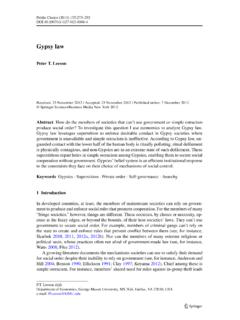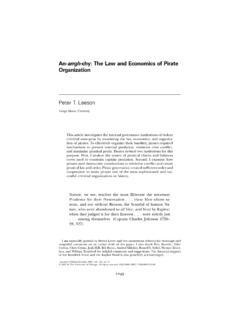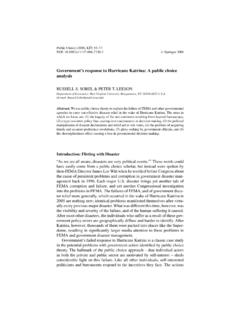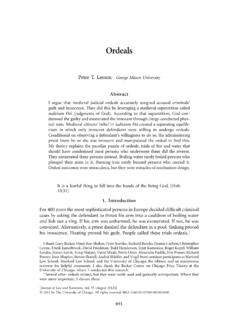Transcription of Symposium The Political, Economic, and Social …
1 SymposiumThe political , economic , and Social Aspectsof KatrinaPeter Boettke,* Emily Chamlee-Wright,{Peter Gordon,{Sanford Ikeda,1 Peter T. Leeson,Iand Russell Sobel#In this paper, we examine the resiliency of community recovery after a natural disaster. Weargue that a resilient recovery requires robust economic /financial institutions, political /legalinstitutions, and Social /cultural institutions. We explore how politically and privately createddisaster preconditions and responses have contributed to or undermined institutionalrobustness in the context of the Gulf Coast s recovery after Hurricane Katrina. We find thatwhere postdisaster resiliency has been observed, private-sector responses contributing to thehealth of these institutional arenas are largely responsible.}}
2 Where postdisaster fragility andslowness has been observed, public-sector responses contributing to thefrailty of theseinstitutional arenas are largely the cause. In other words, we engage in a comparativeinstitutional analysis of civil society, entrepreneurial commercial society, and governmentagencies and political actors in the wake of a natural Classification: P16, P17, H111. IntroductionDisasters, whether man-made or natural, represent a natural experiment for socialscientists. As one business leader put it to us on one of our first research trips in February 2006to New Orleans after the storm, Heck, I understand it is not every day thatyou can flood a cityof half a million people and see what happens.
3 The tragic dimensions of the event in terms oflives lost and lives disrupted must never be forgotten, but the opportunity to learn about theresiliency of Social systems also must not be disasters are the Social scientist s* Department of Economics, George Mason University, MSN 3G4 Fairfax, VA 22030, USA; corresponding author.{Department of Economics, Beloit College, Campbell Hall, 700 College Street, Beloit, WI 53511, USA.{School of Public Policy, Planning, and Development, University of Southern California, Los Angeles, CA90089-0626, of Economics, Purchase College, State University of New York,735 Anderson Hill Road,Purchase, NY 10577, of Economics, West Virginia University, Morgantown, WV 26506-6025, USA.}}
4 #Department of Economics, West Virginia University, Morgantown, WV 26506-6025, Rothschild at the Mercatus Center has been an invaluable project manager and partner in the coordinationof research since the inception of our five-year and resiliency as welfare criterion in assessing political - economic systems moves the discussion from idealallocative efficiency within a clearly defined institutional structureto a focus on the character of the institutionalstructure itself. For a discussion of the implications for political economy of moving the analytical focus from idealefficiency to the robustness of institutions and the strategy for doing so, see Levy (2002) and Boettke and Leeson(2004).
5 Southern economic Journal2007, 74(2), 363 376363equivalent to tests done by engineers to learn about the strength of materials and can be learned about the political economy of everyday life when we examine behaviorunder conditions of great Stuart Mill, in fact, argued in hisPrinciples of political Economythat it is a surprisingfact of life how robust free economies are in the wake of perpetual consumption and reproduction of capital affords the explanation of what has sooften excited wonder, the great rapidity with which countries recover from a state ofdevastation; the disappearance, in a short time, of all traces of the mischiefs done byearthquakes, floods, hurricanes, and the ravages of war.
6 An enemy lays waste a country by fireand sword, and destroys or carries away nearly all the moveable wealth existing in it; all theinhabitants are ruined, and yet, in a few years after, everything is much asit was before (Mill1848, pp. 74 5).Mill argued that the possibility of rapid recovery mainly depends on whether or not the countryhas suffered massive depopulation or not. But there are other issues involved as well as thehuman capital embodied in the population. The free flow of labor and capital seems to be animportant aspect, as well. In addition, the ability to quickly reestablish clearly defined andenforced property rights seems to be a characteristic in common with rapidrecoveries fromdisaster.
7 Jack Hirshleifer (2002) in his essay Disaster and Recovery states clearly that: Historical experience suggests that recovery will hinge upon the ability of government tomaintain and restore property rights together with a market system that will support theeconomic division of labor. Hurricane Katrina offers us some unique challenges. First is the magnitude of the was estimated early on to have caused between $100 billion and $125billion worth ofdamage (more than half of that attributed to the New Orleans flood), whereas the costliesthurricane to that date in history was Hurricane Andrew (1993), which cost roughly$44 billion.
8 The massive amount of debris generated by the storm some 100 million cubicyards, or 35 times the rubble generated by the September 11 attacks in Manhattan madesimply cleaning up the Gulf Coast a uniquely Herculean , problems associated with the state of affairs before the storm could contributeto nonresiliency. New Orleans, for example, was not a particularly good environment forbusiness before fact, it ranked at the bottom on various measures of economicfreedom and the costs of doing business. As a result, few major businesses were located in thecity. Only one Fortune 500 company, Entegry, is headquartered in the andregulations did not attract businesses.
9 New Orleans was instead an economy dominated bypolitics and political connections. There is a reason why New Orleans was often portrayed asthe stereotypical corrupt southern city. Historically, New Orleans and Louisiana were in factextremely politicized environments with numerous high-profile examples of graft addition, the population in Orleans Parish was poor and undereducated compared withnational averages ( , median household income was roughly $27,000, whereas the national2In the Pacific Research Institute s economic Freedom of the States Index,Louisiana ranks 40th out of 50 states interms of economic freedom (see Huang, McCormick, and McQuillan 2004).)
10 3 According to one study published in 2004 ranking states by measures ofcorruption, Louisiana was ranked thethird most corrupt. Mississippi was ranked the most corrupt (Corporate Crime Reporter 2004).364 Boettke et was $42,000, and roughly 28%of families in New Orleans were living below thepoverty line, whereas the national rate was ). The population was particularly vulnerableto the effect of the storm because, in some areas of the parish, vehicle ownership was very lowand the population was old and , factors involved in the devastation of Katrina highlight how thefolly of mancompounds the fury of nature. Government-subsidized flood insurance ledto excessiveconstruction in areas most vulnerable to flooding.






